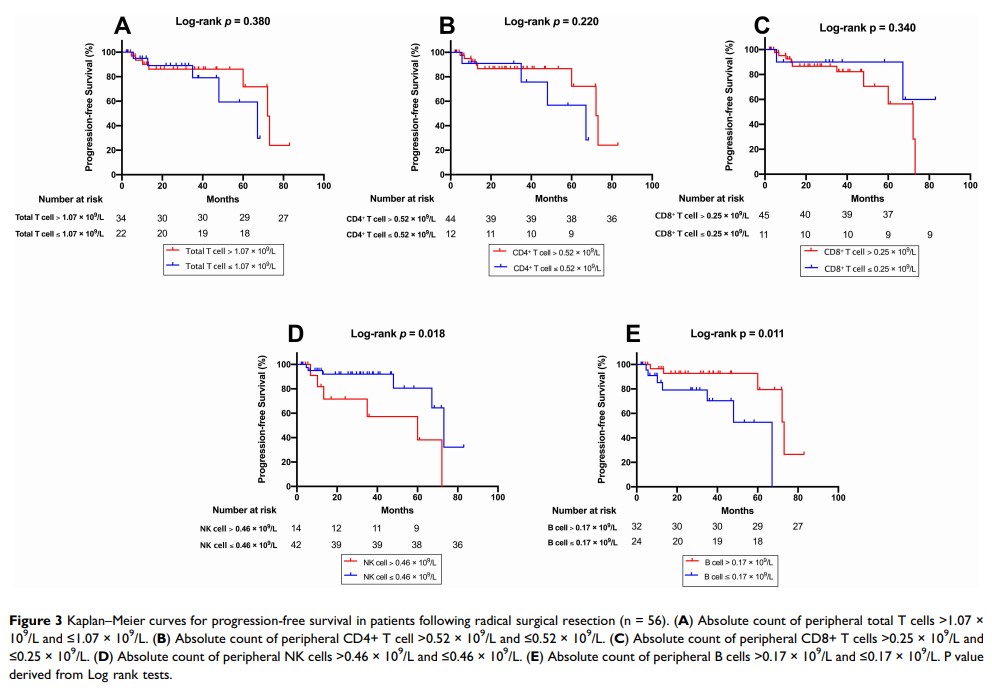108384
论文已发表
注册即可获取德孚的最新动态
IF 收录期刊
- 3.4 Breast Cancer (Dove Med Press)
- 3.2 Clin Epidemiol
- 2.6 Cancer Manag Res
- 2.9 Infect Drug Resist
- 3.7 Clin Interv Aging
- 5.1 Drug Des Dev Ther
- 3.1 Int J Chronic Obstr
- 6.6 Int J Nanomed
- 2.6 Int J Women's Health
- 2.9 Neuropsych Dis Treat
- 2.8 OncoTargets Ther
- 2.0 Patient Prefer Adher
- 2.2 Ther Clin Risk Manag
- 2.5 J Pain Res
- 3.0 Diabet Metab Synd Ob
- 3.2 Psychol Res Behav Ma
- 3.4 Nat Sci Sleep
- 1.8 Pharmgenomics Pers Med
- 2.0 Risk Manag Healthc Policy
- 4.1 J Inflamm Res
- 2.0 Int J Gen Med
- 3.4 J Hepatocell Carcinoma
- 3.0 J Asthma Allergy
- 2.2 Clin Cosmet Investig Dermatol
- 2.4 J Multidiscip Healthc

外周淋巴细胞亚群的绝对计数与胰腺神经内分泌肿瘤患者的无进展生存期和转移状况相关
Authors Gong Y, Fan Z, Luo G, Huang Q, Qian Y, Cheng H, Jin K, Ni Q, Yu X, Liu C
Received 21 April 2020
Accepted for publication 21 June 2020
Published 3 August 2020 Volume 2020:12 Pages 6727—6737
DOI https://doi.org/10.2147/CMAR.S257492
Checked for plagiarism Yes
Review by Single anonymous peer review
Peer reviewer comments 2
Editor who approved publication: Professor Rudolph Navari
Purpose: Pancreatic neuroendocrine tumours (panNETs) are rare tumours of pancreas. Lymphocyte subsets in the peripheral blood are reported to reflect tumour prognosis and progression. The objective of the study is to investigate the hypotheses that the levels of peripheral lymphocytes may reflect tumour progression and may predict the prognosis of pancreatic neuroendocrine tumours (panNETs).
Patients and Methods: A retrospective cohort study consisting of 73 patients diagnosed with panNETs was conducted. Kaplan–Meier methods and Log rank tests were used to compare the survival rates, and a Cox regression model was used to perform multivariate analyses.
Results: panNET patients with distant metastasis were associated with lower peripheral total T cell (p = 0.039) and CD4+ T cell (p = 0.006) counts. Lower peripheral B cells (p = 0.007) and higher peripheral NK cell (p = 0.001) counts indicated worse progression-free survival (PFS) in Log rank tests. In multivariate analyses, low B cell count (hazard ratio (HR): 6.769, 95% confidence interval (CI): 2.158 to 21.228, p = 0.001) and high NK cell count (HR: 3.715, 95% CI: 1.164 to 11.855, p = 0.027) were independent risk factors for progression. NK cells and B cells were also significantly associated with PFS following radical surgical resection.
Conclusion: Peripheral total T cell and CD4+ T cell counts may reflect the distant metastasis status in panNET patients. The absolute count of peripheral B cells and NK cells may independently predict the progression of panNET patients, making them promising prognostic indicators and potential targets for treatment of panNETs.
Keywords: pancreatic neuroendocrine tumours, panNETs, lymphocyte subsets, progression-free survival, B cells
